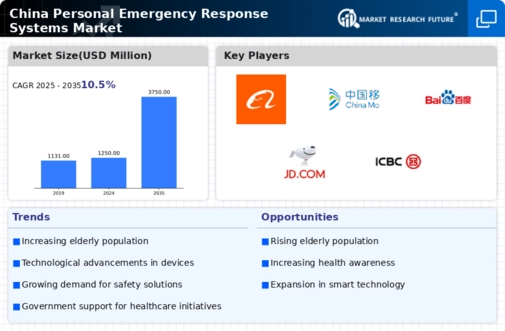The personal emergency-response-systems market in China is characterized by a dynamic competitive landscape, driven by an increasing demand for safety and security solutions among the aging population. Key players are actively engaging in strategies that emphasize innovation, regional expansion, and partnerships to enhance their market presence. Companies such as Philips (NL), Life Alert (US), and ADT (US) are at the forefront, leveraging their technological expertise and brand recognition to capture market share. Philips (NL) focuses on integrating advanced health monitoring technologies into its emergency-response systems, while Life Alert (US) emphasizes its long-standing reputation for reliability and customer service. ADT (US) is pursuing a strategy of digital transformation, enhancing its service offerings through smart home integration, which collectively shapes a competitive environment that is increasingly reliant on technological advancements and customer-centric solutions.
In terms of business tactics, companies are localizing manufacturing and optimizing supply chains to reduce costs and improve service delivery. The market appears moderately fragmented, with several players vying for dominance, yet the collective influence of major companies is significant. This competitive structure allows for a diverse range of products and services, catering to various consumer needs and preferences, while also fostering innovation through competition.
In October 2025, Philips (NL) announced the launch of a new line of wearable emergency-response devices that incorporate AI-driven health monitoring features. This strategic move is likely to enhance user engagement and provide real-time health insights, positioning Philips as a leader in the integration of technology within personal emergency-response systems. The introduction of these devices may not only attract new customers but also strengthen brand loyalty among existing users.
In September 2025, Life Alert (US) expanded its service offerings by partnering with a leading telehealth provider to integrate remote health consultations into its emergency-response services. This partnership is strategically important as it enhances the value proposition for customers, allowing them to access medical advice during emergencies, thereby potentially increasing customer retention and satisfaction.
In August 2025, ADT (US) completed the acquisition of a regional competitor, which is expected to bolster its market presence in key urban areas. This acquisition aligns with ADT's strategy to expand its footprint and enhance service capabilities, indicating a trend towards consolidation in the market. Such strategic actions may lead to improved operational efficiencies and a stronger competitive position in the rapidly evolving landscape.
As of November 2025, current trends in the personal emergency-response-systems market include a pronounced shift towards digitalization, sustainability, and the integration of AI technologies. Strategic alliances are increasingly shaping the competitive landscape, enabling companies to leverage complementary strengths and enhance their service offerings. Looking ahead, competitive differentiation is likely to evolve from traditional price-based competition to a focus on innovation, technology integration, and supply chain reliability, as companies strive to meet the growing expectations of consumers in a rapidly changing market.















Leave a Comment